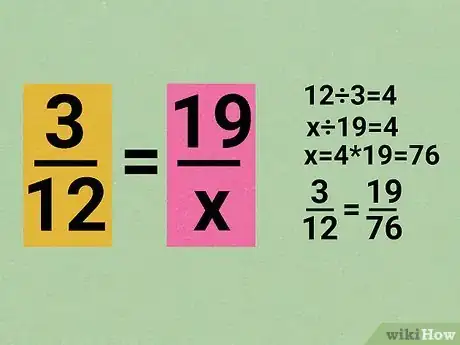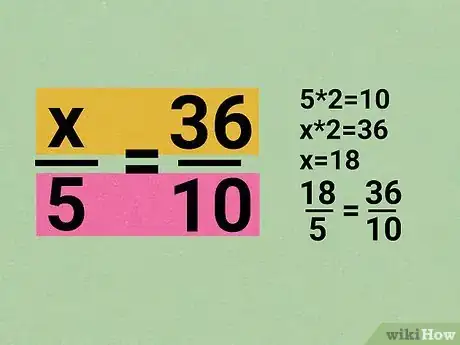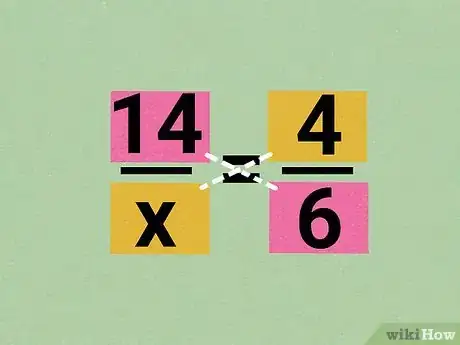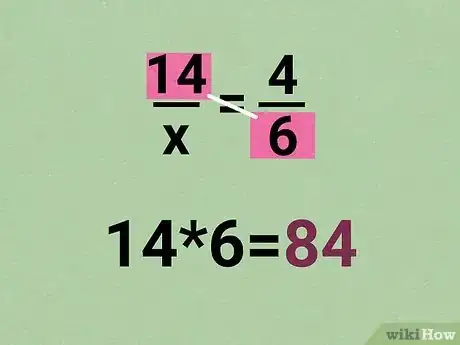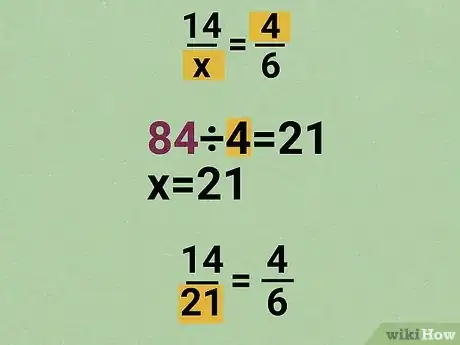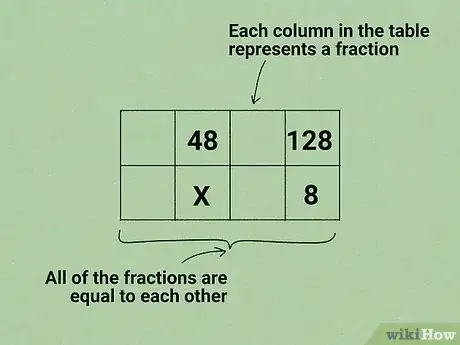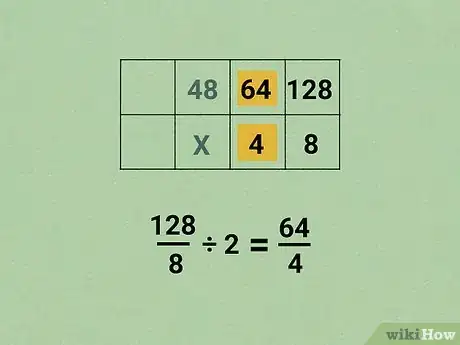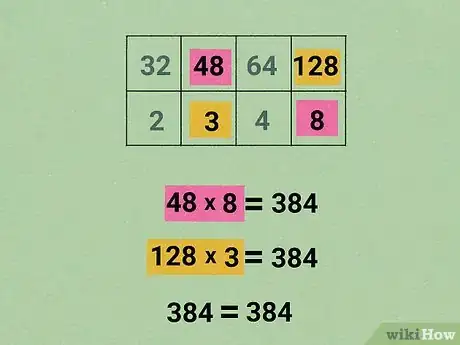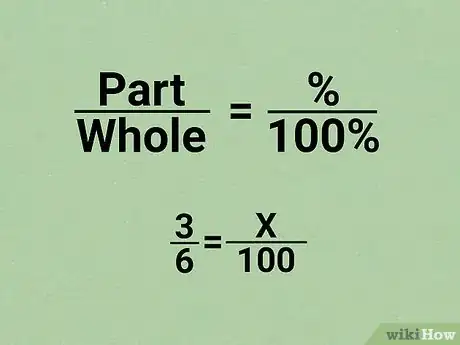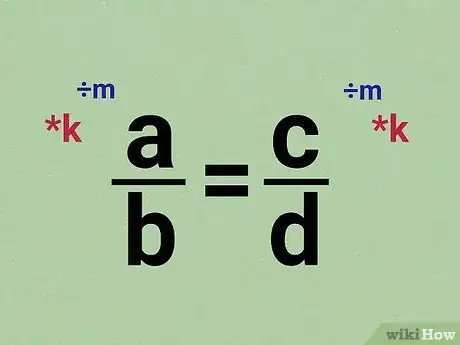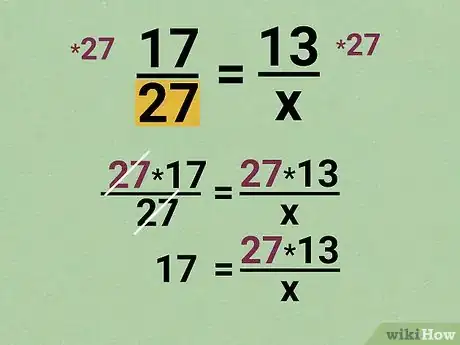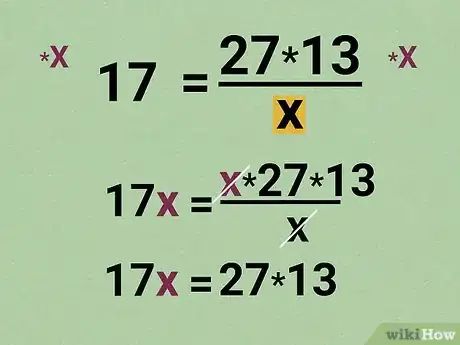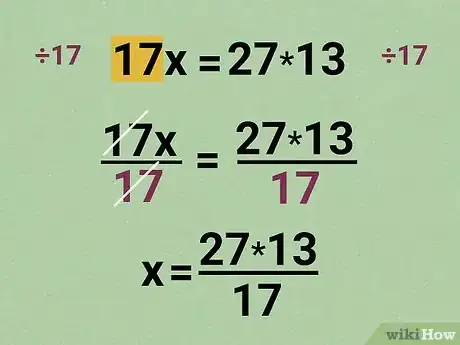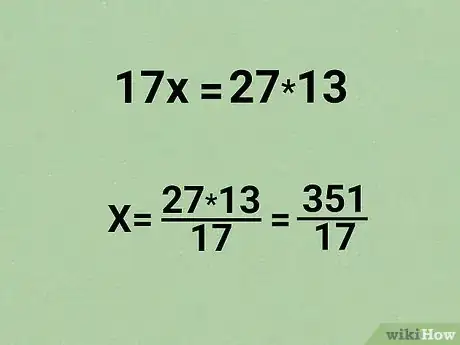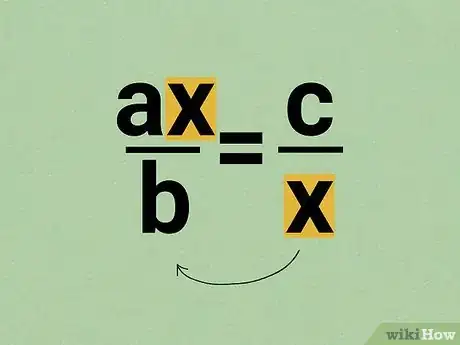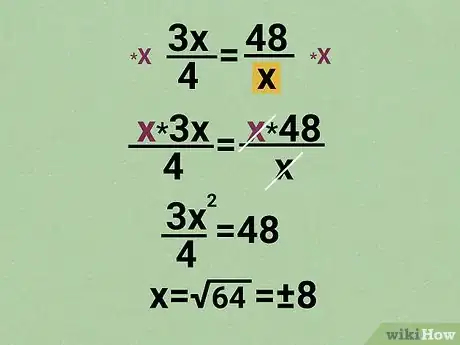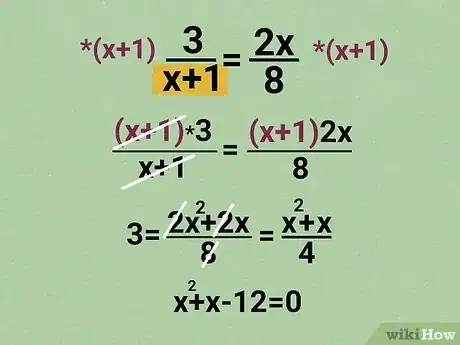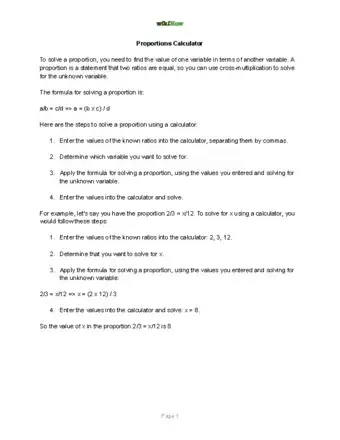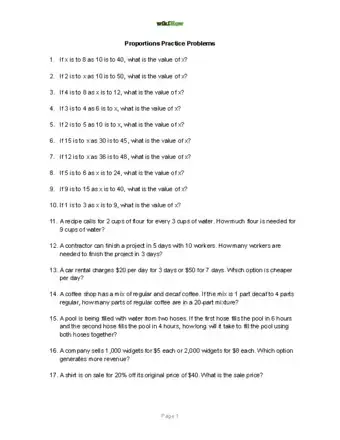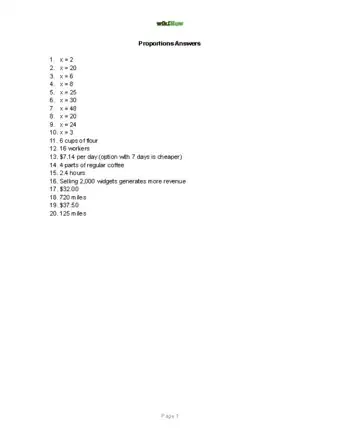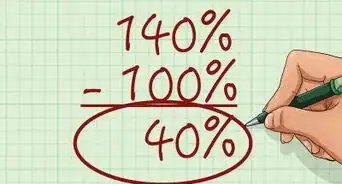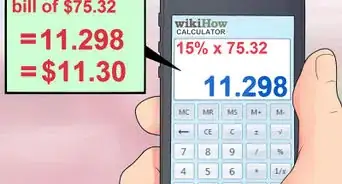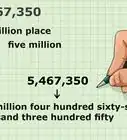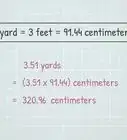This article was co-authored by wikiHow Staff. Our trained team of editors and researchers validate articles for accuracy and comprehensiveness. wikiHow's Content Management Team carefully monitors the work from our editorial staff to ensure that each article is backed by trusted research and meets our high quality standards.
This article has been viewed 52,226 times.
Learn more...
You've already met fractions like . A proportion is a pair of fractions that are equal to each other, like . There are many different ways to solve proportion problems that ask you to find the missing number , and you don't need to learn all of them today. If you're learning pre-algebra and are just starting to use proportions, read from the top until you find a method that makes sense to you. If you're taking algebra and are working on more advanced proportions problems, you might need to skip down to later methods.
Steps
How do I solve a proportion step by step by cross-multiplying?
-
1Draw two diagonal lines in an "X" across the proportion. For example, write down this proportion, then draw one line between the purple terms, and another line between the green terms:
-
2Multiply the two numbers connected by a line. One of the lines will connect two numbers (instead of a number and a variable like ). Find the product of these two numbers:
-
3Divide by the last number in the proportion. Take the answer to your multiplication problem and divide it by the number you haven't used yet. (This is the green number in the example.) The result is the value of , the missing number in your proportion.
- , so you can fill in your proportion like this:
How do you find the missing value in a proportion with a table of ratios?
-
1Draw a table with two rows. Put the top numbers in your proportion in the top row, and the bottom numbers in the second row. Keep numbers in the same fraction in the same column, and leave a few empty columns between them and to either side.[2] Here's an example for the problem :
48 128 x 8 - Each column in this table represents a fraction. All of the fractions in this table are equal to each other.
-
2Add equivalent fractions to your table. Start with the fraction where you know both numbers, then multiply or divide each number in that column by the same amount. Write the new fraction into your table, putting it in a column so that the numbers are in order:
- For example, try dividing the top and bottom of by 2. This gives you a new fraction, , to put in your table.
48 64 128 x 4 8
-
3Repeat until you notice the pattern. As you find new fractions, make sure to put them in the table so that the numbers are in order. This will help you narrow down options for the value of x.
- Both the top and bottom of are divisible by 2 again, giving you the fraction .
32 48 64 128 2 x 4 8 - The x in your table is somewhere between 2 and 4. Let's try 3 by plugging it back into your proportion:
-
4Check your work. Always check your work with this method. Sometimes the answer won't be a whole number, and you'll have to add fractions to your table or use a different method.
- To check whether is the correct solution, draw two diagonal lines across the fraction. Multiply the two numbers along one line: .
- Now multiply the two numbers along the other line: .
- The two answers are the same, which means your answer is correct.
How do you solve percent proportions?
-
1Rewrite the problem as a proportion. You can write any percentage as a fraction of 100. Use this fact to set up a problem as a proportion (two equal fractions):
- The proportion will always follow the form . For word problems, the "part" usually appears next to the word "is", and the "whole" usually comes after the word "of".[3]
- For example, "3 is what percentage of 6?" can be rewritten as . The percentage is unknown, so we write it as and solve for it.
-
2Solve by cross-multiplying or any other method. Now that it's set up as a proportion, you can solve the problem by any method. One of the most common methods is cross-multiplication:
- First multiply across the diagonal line with two known numbers. For the proportion , that means multiplying .
- Now divide your answer by the last remaining number in the proportion: .
- and the complete proportion is
How do you solve proportions algebraically?
-
1Treat the proportion as an algebraic equation. Proportions are usually introduced in a pre-algebra class. But as you move on to algebra, you'll learn that a proportion is just one kind of algebraic equation. For any algebraic equation, there's one big rule:
- You can change the left hand side of the equation, as long as you do the same math to the right hand side.
-
2Multiply each side by a denominator. When solving for an unknown value in an algebraic equation, your goal is to get alone on one side. When the is stuck inside a fraction, like in all proportion problems, a good way to start is to cancel out those fractions.
- For example, start with the proportion .
- To get rid of the fraction on the left, multiply both sides by 27:
- The 27s on the left cancel out:
-
3Multiply each side by the other denominator. This will get rid of the other fraction. You can do this even if the denominator is the , as shown here:
- The two s on the right cancel out:
-
4Divide to get by itself. Now you should have one side of the equation that's just multiplied by another number. Divide each side by that number to get alone:
- The 17s on the left cancel out:
-
5Simplify your answer or leave as-is. You can now plug your result into a calculator (or calculate by hand) and find the value of . Sometimes, the answer won't simplify to a whole number or even an easy decimal. In that case, it's best to leave your answer as a fraction.
- One big advantage to this method is that it works even when is a difficult number like this. But if this didn't make much sense to you, that's okay: most teachers and textbooks start with the other methods above and teach you algebra a little later.
How do you solve a proportion with a variable on both sides?
-
1Realize your goal is to get the variable on one side. More difficult proportion problems have an on both sides of the equal sign. This works just like any proportion, but you'll have to use algebra to handle the variable . Your goal is to get every in the equation onto one side, so you can simplify it into one and find the answer.
-
2If one is a denominator, multiply both sides by . If the bottom of one fraction is , then this will already get the on one side. From that point on, normal algebra will get you to the answer:
- Multiply by on both sides:
- Simplify:
- Multiply by 4 on both sides:
- Simplify:
- Divide by 3 on both sides:
- Simplify:
- Find the square root:
-
3Otherwise, multiply by the entire denominator with . Multiplying by only part of the denominator will not help you get rid of the fraction. Always multiply by the entire denominator:
- Warning: This is a difficult example. If you haven't learned about quadratic equations yet, you might want to skip this part.
- Multiply by :
- Simplify. Remember to multiply with both terms in the parentheses, and add the results together:
- The fraction on the right has terms that are all divisible by 2. Simplify:
- Multiply by 4 on both sides:
- Simplify:
- Subtract 12 to get zero on one side:
- You can now solve this as a quadratic equation, using any method that you've learned.
- For example, you can factor this as , then solve for and to get your two answers, and .
Proportions Calculator, Practice Problems, and Answers
Community Q&A
-
QuestionWhat are the properties of proportions?
 wikiHow Staff EditorThis answer was written by one of our trained team of researchers who validated it for accuracy and comprehensiveness.
wikiHow Staff EditorThis answer was written by one of our trained team of researchers who validated it for accuracy and comprehensiveness.
Staff Answer wikiHow Staff EditorStaff AnswerThere are many properties of proportion, but here are the first 3: 1) If two ratios are equal, this is called a proportion. In other words, in a proportion, a/b = c/d. 2) The quantities a, b, c, and d are the “terms” of the proportion. The first and fourth terms (a and d) are the “extremes.” The second and third (b and c) are the “means.” 3) In a proportion, the product of the extremes equals the product of the means. In other words, if a/b = c/d, then a x d = b x c. This is the “cross product rule.”
wikiHow Staff EditorStaff AnswerThere are many properties of proportion, but here are the first 3: 1) If two ratios are equal, this is called a proportion. In other words, in a proportion, a/b = c/d. 2) The quantities a, b, c, and d are the “terms” of the proportion. The first and fourth terms (a and d) are the “extremes.” The second and third (b and c) are the “means.” 3) In a proportion, the product of the extremes equals the product of the means. In other words, if a/b = c/d, then a x d = b x c. This is the “cross product rule.” -
QuestionWhat is the formula of a proportion?
 wikiHow Staff EditorThis answer was written by one of our trained team of researchers who validated it for accuracy and comprehensiveness.
wikiHow Staff EditorThis answer was written by one of our trained team of researchers who validated it for accuracy and comprehensiveness.
Staff Answer wikiHow Staff EditorStaff AnswerThere are many formulae that can apply to proportions, but the basic starting point is a/b = c/d. Going from there, you can get a variety of other formulae, such as a x d = b x c and b^2 = a x c.
wikiHow Staff EditorStaff AnswerThere are many formulae that can apply to proportions, but the basic starting point is a/b = c/d. Going from there, you can get a variety of other formulae, such as a x d = b x c and b^2 = a x c. -
QuestionWhat is a proportion example?
 wikiHow Staff EditorThis answer was written by one of our trained team of researchers who validated it for accuracy and comprehensiveness.
wikiHow Staff EditorThis answer was written by one of our trained team of researchers who validated it for accuracy and comprehensiveness.
Staff Answer wikiHow Staff EditorStaff AnswerAny 2 fractions with different terms that are equal is a proportion. For example, 1/2 = 3/6 or 2/3 = 6/9 are both examples of proportions.
wikiHow Staff EditorStaff AnswerAny 2 fractions with different terms that are equal is a proportion. For example, 1/2 = 3/6 or 2/3 = 6/9 are both examples of proportions.
References
About This Article
To solve proportions, start by taking the numerator, or top number, of the fraction you know and multiplying it with the denominator, or bottom number, of the fraction you don’t know. Next, take that number and divide it by the denominator of the fraction you know. Now you can replace x with this final number. For example, to figure out “x” in the problem 3/4 = x/8, multiply 3 x 8 to get 24, then divide 24 / 4 to get 6, or the value of x. To learn how to use proportions to determine percentages, read on!



